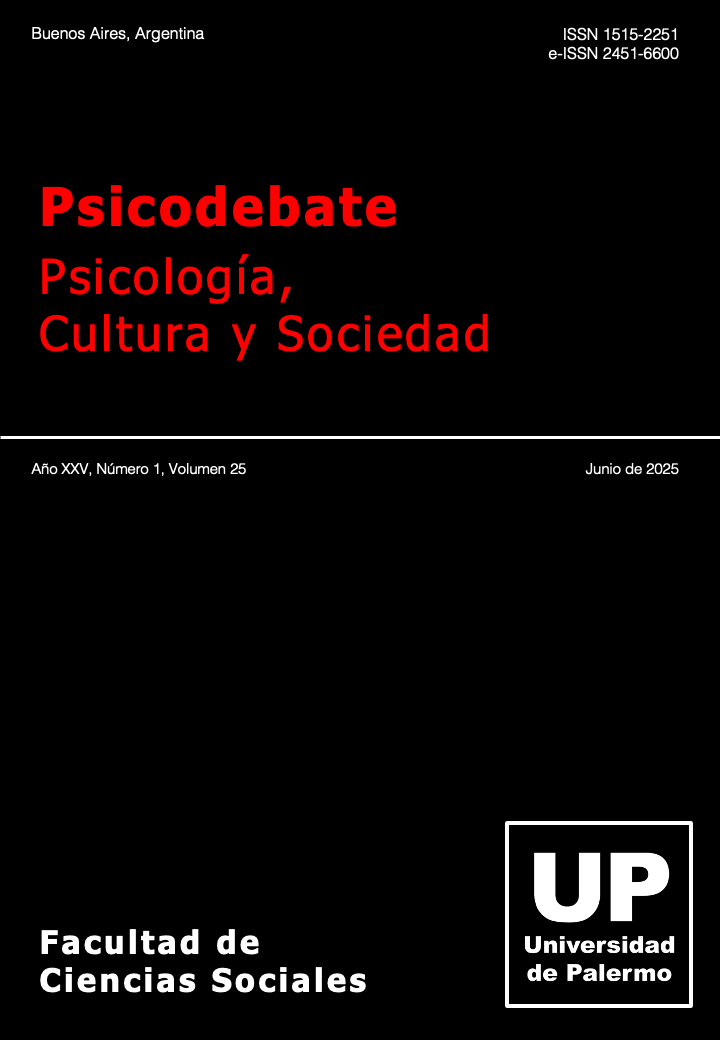Validación de la escala CAPEMI-E: Un estudio preliminar en una muestra de adolescentes de Fray Bentos, Uruguay
Resumen
Los rasgos positivos son características positivas humanas duraderas y valoradas que se manifiestan en pensamientos, sentimientos y comportamientos. Una forma de estudiar los rasgos positivos es a través de un enfoque psicoléxico. En este tipo de abordaje se investigan las diferencias individuales de los rasgos positivos que se encuentran codificados en la lengua natural de los sujetos. Un instrumento que deriva de este enfoque es el CAPEMI-E, confeccionado en población argentina y cuya estructura de rasgos positivos se encuentra conformada por los rasgos: Erudición, Jovialidad, Honestidad, Paz, Espiritualidad, Tenacidad. El objetivo de este estudio fue validar el CAPEMI-E en adolescentes de Uruguay. Además, se analizaron diferencias individuales de estos rasgos en función del género y la edad. Se recolectaron datos de 400 adolescentes de Fray Bentos, Uruguay. Se encontró que la estructura original de seis rasgos positivos no se replicaba. En su lugar, se presentó una estructura de cinco rasgos: Erudición, Jovialidad, Honestidad, Paz y Espiritualidad con adecuados niveles de consistencia interna (alfas/omegas = .66/.84). Las mujeres mostraron niveles más elevados que los hombres en el rasgo Honestidad, y que Erudición, Paz y Honestidad fueron los rasgos con mayor presencia en los adolescentes mayores de 16 años. El CAPEMI-E ha demostrado ser una herramienta válida y confiable para medir rasgos positivos en jóvenes uruguayos. Esto es particularmente relevante, dado que los rasgos positivos juegan un papel clave en la salud mental y el bienestar de los adolescentes.
Descargas
Citas
Allemand, M., Zimprich, D., & Hendriks, A. A. J. (2008). Age differences in five personality domains across the life span. Developmental Psychology, 44(3), 758– 770. https://doi.org/10.1037/0012-1649.44.3.758
American Psychological Association. (2010). Publication manual of the American Psychological Association (6th ed.). American Psychological Association.
Andersen, H., & Hepburn, B. (2016). Scientific method. En E. Zalta (Ed.), The Stanford Encyclopedia of Philosophy (pp. https://plato.stanford.edu/entries/scientific- method/). Metaphysics Research Lab, Stanford University
Anjum, A., & Amjad, N. (2020). Values in action inventory of strengths (VIA-IS): Translation and validation in Urdu language. Pakistan Journal of Psychological Research, 35(1), 163-189. https://doi.org/10.33824/PJPR.2020.35.1.10
Asselmann, E., & Specht, J. (2021). Personality maturation and personality relaxation: Differences of the Big Five personality traits in the years around the beginning and ending of working life. Journal of Personality, 89(6), 1126-1142. https://doi.org/10.1111/jopy.12640
Bentler, P.M. (2006). EQS 6 Structural equation program manual. Multivariate Software Inc.
Brdar, I., & Kashdan, T. (2010). Character strengths and well-being in Croatia: An empirical investigation of structure and correlates. Journal of Research in Personality. Journal of Research in Personality, 44, 151-154. https://doi.org/10.1016/j.jrp.2009.12.001
Brdar, I., Anić, P., & Rijavec, M. (2011). Character Strengths and Well-Being: Are There Gender Differences? En I. Brdar (Ed.), The Human Pursuit of Well-Being (pp. 145- 156). Springer. https://doi.org/10.1007/978-94-007-1375-8_13
Bruna, M. O., Brabete, A. C., & Izquierdo, J. M. A. (2019). Reliability generalization as a seal of quality of substantive meta-analyses: The case of the VIA Inventory of Strengths (VIA-IS) and their relationships to life satisfaction. Psychological Reports, 122(3), 1167-1188. https://doi.org/10.1177/0033294118779198
Caetano, G. (2019). Historia mínima del Uruguay. El Colegio de México.
Castro Solano, A. (2018). Personalidad Positiva. Aproximación émica y teórico-racional. En Fundación AIGLÉ (Ed.), Enciclopedia Argentina de la Salud Mental (pág. http://www.enciclopediasaludmental.org.ar/trabajo.php?idt=13yidtt=35). Fundacion Aiglé.
Castro Solano , A., & Cosentino, A. (2018). IVyF abreviado -IVyFabre-: análisis psicométrico y de estructura factorial en Argentina. Avances en Psicología Latinoamericana, 36(3), 619-637. http://dx.doi.org/10.12804/revistas.urosario.edu.co/apl/a.4681
Castro Solano, A., & Cosentino , A. (2016a). Una aproximación léxica al Estudios de las Características Psicológicas Humanas Positivas. Un estudio con Población Argentina. Perspectivas en psicología, 13(2), 75-83.
Castro Solano, A., & Cosentino, A. (2016b). The relationships between character strengths and life fulfillment in The view of lay-people in Argentina. Interdisciplinaria: Revista de Psicología y Ciencias Afines, 33(1), 65-80. https://doi.org/10.16888/interd.2016.33.1.4
Castro Solano, A., & Cosentino, A. (2017). High Five Model: Los factores Altos están Asociados con Bajo Riesgo de Enfermedades Médicas, Mentales y de Personalidad. Psicodebate, 17(2), 69-82. https://doi.org/10.18682/pd.v17i2.712.
Castro Solano, A., & Cosentino, A. (2019). The High Five Model: Associations of the High Factors With Complete Mental Well-Being and Academic Adjustment in University Students. Europe's Journal of Psychology, 15(4), 656–670. https://doi.org/ 10.5964/ejop.v15i4.1759
Castro Solano, A., Lupano Perugini, M.L., Caporiccio Trillo M. A. & Cosentino, A. (2024). Validación de un Modelo de Rasgos Positivos y Negativos de Personalidad como Predictores del Bienestar Psicológico aplicando Algoritmos de Machine Learning. Ciencias Psicológicas. 18(1). https://doi.org/10.22235/cp.v18i1.3286
Cawley III, M., James, E., & Johnson, J. (2000). A virtues approach to personality. Personality and Individual Diferences, 28, 997-1013. https://doi.org/10.1016/S0191-8869(99)00207-X
Cheung, F., van de Vijver, F., & Leong, F. (2011). Toward a New Approach to the Study of Personality in Culture. American Psychologist, 66(7), 593–603. https://doi.org/10.1037/a0022389
Cheung, G. W., Cooper‑Thomas, H. D., Lau, R. S., & Wang, L. C. (2024). Correction to: Reporting reliability, convergent and discriminant validity with structural equation modeling: A review and best-practice recommendations. Asia Pacific Journal of Management, 41(2), 785-787. https://doi.org/10.1007/s10490-023-09880-x
Chow, S. (2002). Methods in Psychological Research. Encyclopedia of Life Support Systems.
Cosentino, A. (2011). Fortalezas del carácter en militares argentinos [Tesis doctoral]. Universidad de Palermo.
Cosentino, A., & Castro Solano , A. (2017). The High Five: Associations of the Five Positive Factors with the Big Five and Well-being. Frontiers in Psychology, 8, 1250. https://doi.org/10.3389/fpsyg.2017.01250.
Cronbach, L. (1951). Coefficient alpha and the internal structure of tests. Psychometrika, 16(3), 297-334. https://doi.org/10.1007/BF02310555
Dahlsgaard, K., Peterson, C., & Seligman, M. (2005). Shared Virtue: The Convergence of Valued Human Strengths Across Culture and History. Review of General Psychology, 9(3), 203-213. https://doi.org/10.1037/1089-2680.9.3.203
Dametto, D., & Noronha, A. (2021). Study between personality traits and character strengths in adolescents. Current Psychology, 40(5), 2067–2072. https://doi.org/10.1007/s12144-019-0146-2
de la Iglesia, G., Lupano Perugini, M. L. & Castro Solano, A. (2019). Modelo de Personalidad Positiva: su asociación al funcionamiento óptimo en trabajadores activos. Revista de Psicología, 37(2), 425-449. https://doi.org/10.18800/psico.201902.003
De Raad, B. (2000). The Big Five Personality Factors: The psycholexical approach to personality. Hogrefe y Huber Publishers.
De Raad, B., & Van Oudenhoven, J. (2011). A psycholexical study of virtues in the Dutch language, and relations between virtues and personality. European Journal of Personality, 25(1), 43–52. https://doi.org/10.1002/per.777
De Raad, B., Barelds, D., Timmerman, M., De Roover, K., Mlačić, B., & Church, A. (2014). Towards a Pan-cultural Personality Structure: Input from 11 Psycholexical Studies. European Journal of Personality, 28(5), 497– 510.doi:10.1002/per.1953.
De Raad, B., Nagy, J., Szirmák, Z., & Barelds, D. P. (2018). Taxonomy of Hungarian personality traits: Replication and refinement. International Journal of Personality Psychology, 4, 1-12. https://ijpp.rug.nl/article/view/31079
De Raad, B., Timmerman, M., Morales-Vives, F., Renner, W., Barelds, D., & Pieter Van Oudenhoven, J. (2017). The Psycho-Lexical Approach in Exploring the Field of Values. Journal of Cross-Cultural Psychology, 48(3), 444–451. https://doi.org/10.1177/0022022117692677.
De Vries, R. E. (2020). The main dimensions of sport personality traits: A lexical approach. Frontiers in Psychology, 11, 2211. https://doi.org/10.3389/fpsyg.2020.02211
Duan, W., Ho, S., Yu, B., Tang, X., Zhang, Y., Li, T., & Yuen, T. (2012). Factor structure of the Chinese virtue’s questionnaire. Research on Social Work Practice, 22(6), 680-688. https://doi.org/10.1177/1049731512450074
Duckworth, A. L., Steen, T. A., & Seligman, M. E. (2005). Positive psychology in clinical practice. Annual review of clinical psychology, 1, 629–651. https://doi.org/10.1146/annurev.clinpsy.1.102803.144154
Fadda, D., Scalas, L., Quevedo-Aguado, M., & Benavente Cuesta, M. (2021). The influence of personality factors on well-being through self-esteem: An Italian-Spanish lexical comparative study. Personality and Individual Differences, 1-7. https://doi.org/10.1016/j.paid.2021.110663
Freiberg Hoffmann, A., Stover, J. B., de la Iglesia, G. & Fernández Liporace, M. (2013). Correlaciones Policóricas y Tetracóricas en Estudios Exploratorios y Confirmatorios. Ciencias Psicológicas, 7(2), 151-164. https://doi.org/10.22235/cp.v7i1.1057
George , D., & Mallery, P. (2003). SPSS for Windows step by step: A simple guide and reference. 11.0 update (4th ed.). Allyn y Bacon.
Golberg, L. (1981). Language and individual differences: The search for universals in personality lexicon. En L. Wheeler (Ed.), Review of personality and social psychology (pp. 141-165). SAGE Publications. .
Gomez-Baya, D., Santos, T., & Gaspar de Matos, M. (2021). Developmental assets and positive youth development: an examination of gender differences in Spain. Applied Developmental Science, 1–23. https://doi.org/10.1080/10888691.2021.1906676
Heintz, S., Kramm, C., & Ruch, W. (2017). A meta-analysis of gender differences in character strengths and age, nation, and measure as moderators. The Journal of Positive Psychology, 14(1), 103–112. https://doi.org/10.1080/17439760.2017.1414297
Heintz, S., & Ruch, W. (2021). Cross-sectional age differences in 24 character strengths: Five meta-analyses from early adolescence to late adulthood. The Journal of Positive Psychology, 1-20. https://doi.org/10.1080/17439760.2021.1871938
Helliwell, J. F., Huang, H., Norton, M. B., & Wang, S. (2019). Happiness at different ages: The social context matters. En M. Rojas (Ed.), The Economics of Happiness (pp. 455-481). Springer International Publishing. https://doi.org/10.1007/978-3-030-15835-4_20
Hepburn, B., & Andersen, H. (2015). Scientific method. Metaphysics Research Lab, Stanford University.
Husain, W. (2021). Women are the Better Halves: Gender-based Variations in Virtues and Character Strengths. Journal of Human Values, 28(2), 103-114. https://doi.org/10.1177/09716858211039984
Jiao, L., Yang, Y., Guo, Z., Xu, Y., Zhang, H., & Jiang, J. (2021). Development and validation of the good and evil character traits (GECT) scale. Scandinavian Journal of Psychology, 62(2), 276–287. https://doi.org/10.1111/sjop.12696
Koopman, C., Snyder, J., & Jervis, R. (1990). Theory-Driven versus Data-Driven Assessment in a Crisis. Journal of Conflict Resolution, 34(4), 694–722. https://doi.org10.1177/0022002790034004006.
Lavy, S. (2021). Beyond well-being: Character strengths development in 21st century schools. Educational Psychology/Psicologia dell’Educazione.
Lavy, S., & Benish-Weisman, M. (2021). Character Strengths as “Values in Action”: Linking Character Strengths With Values Theory – An Exploratory Study of the Case of Gratitude and Self-Transcendence. Frontiers in Psychology, 1-9. https://doi.org/10.3389/fpsyg.2021.576189
Maass, W., Parsons, J., Purao, S., Storey, V., & Woo, C. (2018). Data-Driven Meets Theory-Driven Research in the Era of Big Data: Opportunities and Challenges for Information Systems Research. Journal of the Association for Information Systems, 19(12), 1253-1273. https://doi.org/10.3389/fpsyg.2021.576189
McDonald, R. P. (1999). Test theory: A unified treatment. Lawrence Erlbaum Associates, Inc.
McGrath, R. (2014). Scale-and Item-Level Factor Analyses of the VIA Inventory of Strengths. Assessment, 21(1), 4-14. https://doi.org/10.1177/1073191112450612
McGrath, R. (2021). The VIA virtue model: Half-Baked or brilliant? The Journal of Positive Psychology, 1-8. https://doi.org/10.1080/17439760.2021.2016905
Menardo , E., Balboni , G., & Cubelli , R. (2017). Environmental Factors and Teenagers’ Personalities: The Role of Personal and Familial Socio-Cultural Level. Behavioural Brain Research, 325, 181-187. https://doi.org/10.1016/j.bbr.2017.02.038
Morales–Vives, F., De Raad, B., & Vigil–Colet, A. (2012). Psycholexical Value Factors in Spain and Their Relation with Personality Traits. European Journal of Personality, 26(6), 551-565. https://doi.org/10.1002/per.854
Morales-Vives, F., De Raad, B., & Vigil-Colet, A. (2014). Psycho-Lexycally based virtue factors in Spain and their relation with personality traits. The Journal of General Psychology, 141(4), 297-325. https://doi.org/10.1080/00221309.2014.938719
Muthén, B., & Kaplan, D. (1985). A comparison of some methodologies for the factor analysis of non-normal Likert variables. British Journal of Mathematical and Statistical Psychology, 38(2), 171–189. https://doi.org/10.1111/j.2044-8317.1985.tb00832.x
Otake , K., Shimai, S., Ikemi , A., Utsuki , N., Peterson, C., & Seligman , M. (2005). [Development of the Japanese version of the Values In Action Inventory of Strengths (VIA-IS)]. Shinrigaku Kenkyu: The Japanese Journal of Psychology, 76(5), 461-467. https://doi.org/10.4992/jjpsy.76.461
Peterson, C., & Seligman, M. (2004). Character strengths and virtues: A handbook and classification. Oxford University Press.
Postigo, Á., Cuesta, M., Fernández-Alonso, R., García-Cueto, E., & Muñiz, J. (2021). La tenacidad académica modula la evolución del rendimiento escolar: Un análisis de transiciones latentes. Revista de Psicodidáctica, 26(2), 87-95. https://doi.org/10.1016/j.psicod.2021.02.002
Qiu, L., May Chan, S., & Chan, D. (2017). Big data in social and psychological science: theoretical and methodological issues. Journal of Scientific Computing, 1, 59–66. https://doi.org/10.1007/s42001-017-0013-6 .
Ruch, W., Proyer, R., Harzer, C., Park, N., & Seligman, M. (2010). Values in action inventory of strengths (VIA-IS): Adaptation and validation of the German version and the development of a peer-rating form. Journal of Individual Differences, 31(3), 138-149. https://doi.org/10.1027/1614-0001/a000022
Schwartz, S. (2017). Theory-Driven Versus Lexical Approaches to Value Structures: A Comment on De Raad et al. (2016). Journal of Cross-Cultural Psychology, 48(3), 439–443. https://doi.org/10.1177/0022022117690452
Shapiro, S., & Wilk, M. (1965). An analysis of variance test for normality (complete samples). Biometrika, 52(3/4), 591-611. https://doi.org/10.2307/2333709
Shryack , J., Steger , M., Krueger, R., & Kallie, C. (2010). The Structure of virtue: An empirical investigation of the dimensionality of the virtues in action inventory of strengths. Personality and Individual Differences, 48, 714-719. https://doi.org/10.1016/j.paid.2010.01.007
Singh, K., & Choubisa, R. (2010). Empirical validation of values in action-inventory of strengths (VIA-IS) in Indian context. Psychological Studies, 55(2), 151-158. https://doi.org/10.1007/s12646-010-0015-4
Smith, B., Ford, C., Erickson, K., & Guzman, A. (2020). The Effects of a Character Strength Focused Positive Psychology Course on Undergraduate Happiness and Well-Being. Journal of Happiness Studies, 22(1), 343–362. https://doi.org/10.1007/s10902-020-00233-9
Strus, W., Cieciuch, J., & Rowiński, T. (2019). The Polish adaptation of the IPIP-BFM-50 questionnaire for measuring five personality traits in the lexical approach. Roczniki Psychologiczne, 17(2), 347-366. https://doi.org/10.5167/uzh-162943
Thalmayer, A., Saucier, G., Flournoy, J., & Srivastava, S. (2020). Ethics-Relevant Values as Antecedents of Personality Change: Longitudinal Findings from the Life and Time Study. Collabra: Psychology, 2-16. https://doi.org/10.1525/collabra.244
Thielmann, I., Akrami, N., Babarović, T., Belloch, A., Bergh, R., Chirumbolo, A., Čolović, P., de Vries, R. E., Dostál, D., Egorova, M., Gnisci, A., Heydasch, T., Hilbig, B. E., Hsu, K. Y., Izdebski, P., Leone, L., Marcus, B., Međedović, J., Nagy, J., Parshikova, O., … Lee, K. (2020). The HEXACO-100 Across 16 Languages: A Large-Scale Test of Measurement Invariance. Journal of personality assessment, 102(5), 714–726. https://doi.org/10.1080/00223891.2019.1614011
Wainman-Lefley, J., Goudie, N., Richardson, M., & Evans, J. (2022). A pilot feasibility study of a randomized controlled trial of goal setting using the values in action inventory of strengths following brain injury. Neuropsychological Rehabilitation, 32(3), 359-377. https://doi.org/10.1080/09602011.2020.1823428
Walker, L., & Pitts, R. (1998). Naturalistic conceptions of moral maturity. Developmental Psychology, 34(3), 403–419. https://doi.org/10.1037/0012-1649.34.3.403
Derechos de autor 2025 Psicodebate

Esta obra está bajo licencia internacional Creative Commons Reconocimiento 4.0.
Los autores/as que publiquen en esta revista ceden los derechos de autor y de publicación a Psicodebate y aceptan el registro de su trabajo bajo una licencia de atribución de Creative Commons, que permite a terceros utilizar lo publicado siempre que de el crédito pertinente a los autores y a Psicodebate

















